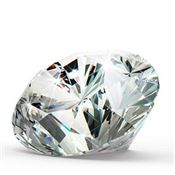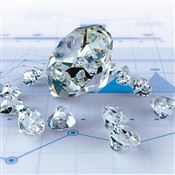Diamond Shapes: What You Need to Know
What are the different shapes of diamonds? Which cut sparkles the most? Find out what the 4Cs won't tell you about diamond shapes and meanings.
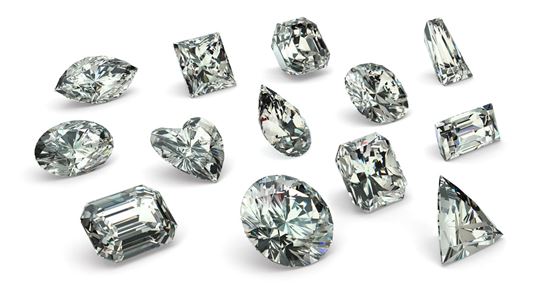 |
Picking the perfect engagement ring means more than just learning the 4C's. Of course, you need to know these details so you don't get ripped off. But it's equally important to find the ring that matches her personality.
Is she classy and elegant? Or daring and bold? Does she like to make her own rules or does tradition matter? A round diamond may be classic, but it's not for everyone.
Diamond shape matters. Each shape is unique. Some have more sparkle, while others look larger but may actually be less expensive. Read on to learn the pros and cons of each shape, including their unique meaning.
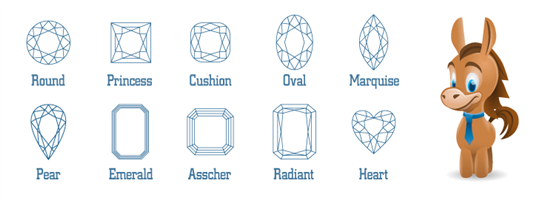 |
| © CreditDonkey |
- Round Brilliant Cut: timeless, classy, traditional:
The ever-popular round diamond has 58 facets, setting the standard for brilliance and beauty. - Princess Cut: dainty, feminine, contemporary:
Stylish and delicate, the square cut princess diamond is perfect for the trendy girl. It has intense sparkle and looks good in just about every setting. - Cushion Cut: soft, classic, romantic:
This "pillow cut" features softly rounded corners for a romantic look. Cushion cut is quickly becoming one of the most popular shapes and dazzles in many settings. - Oval Cut: modern, bold, slenderizing:
Oval diamonds are great for those who like to stand out. They appear larger than round diamonds while making a woman's finger look longer and more slender. - Emerald Cut: art deco, sophisticated, glamorous:
The ultimate vintage shape, the emerald cut diamond exudes old-world glamour. This rectangular step-cut diamond should be appreciated for its luster instead of brilliance. - Asscher Cut: modern vintage, dramatic, elegant:
This 21st-century update to the emerald cut has a square shape and more sparkle. Ideal for the woman with vintage tastes but a modern flair. - Radiant Cut: unique, complex, daring:
Combining the best of a few cuts, the radiant diamond offers fierce sparkle. The cropped corners make it an ideal choice for active women who prefer a square shaped diamond. - Marquise Cut: showy, unique, elongating:
The football-shaped marquise cut diamond appears the largest of all cuts. The long shape is also flattering on short fingers. - Pear Shape: elegant, delicate, flirty:
Also called the teardrop diamond, the pear cut is a cross between the round and marquise styles. It's a unique, beautiful shape that looks beautiful in a halo setting. - Heart Shape: romantic, sweet, sentimental:
The only choice for hardcore romantics. A heart-shaped diamond works best in a solitaire setting that accentuates its shape.
Browse Diamond Inspiration Gallery
Pros and Cons of Most Popular Diamond Cuts
The diamond shape not only affects its look, but also the price, brilliance, and fragility of the diamond.
Read on for the pros and cons of each diamond shape.
- The engagement ring setting style
- The diamond shape
- The type of metal and metal color
- The diamond characteristics (carat, cut, color, clarity)
86% of brides care more about the overall design of the engagement ring, rather than the diamond's quality.
Round Brilliant Cut
 |
| Round Diamond Carat Size Chart © CreditDonkey |
More than half of all engagement rings feature a round center stone, making it by far the most popular diamond shape. Round diamonds are classic and timeless, but also the most brilliant. They are cut to allow for maximum light return.
Advantages:
The intense sparkle can hide flaws and mask color. You can afford to save some money in color and clarity. We suggest a color of H (J for yellow gold bands) and clarity of VS2.
Watch out:
Round cut diamonds are the priciest. They can cost 20% - 40% more than fancy-cut shapes. Most of the raw material is lost when making a round diamond, which factors into the price.
This shape also tends to look smaller compared with other fancy-cut diamond of the same carat weight. Keep this in mind if you have a specific size goal.
Estimate price:
For a 1 carat ideal-cut, H, VS2 round diamond, price is $5,500 - $6,000
Best for:
The classic woman who loves tradition. If you're really not sure what style she prefers, it's hard to go wrong with the timeless round diamond.
View: Round Cut Diamonds on James Allen.
Princess Cut
 |
| Princess Diamond Carat Size Chart © CreditDonkey |
Princess cut diamonds are stylish and contemporary, yet feminine and delicate. Created in the 1960's, this square cut quickly became famous for its stunning brilliance. They're second only to round diamonds in sparkle.
Advantages:
Like round diamonds, princess cuts are so brilliant they can hide a number of flaws. You might save some money on color and clarity. They also look great no matter how small (or large!) the stone and work with almost any kind of setting.
Watch out:
The sharp corners of princess cut diamonds tend to chip. Keep this in mind if your girlfriend does a lot with her hands. You can also protect the rock in a bezel setting.
Estimate price:
For a 1 carat ideal-cut, H, VS2 princess cut diamond, price is $3,700 - $4,500 (via James Allen)
Best for:
The trendy woman.
View: Princess Cut Diamonds on James Allen
Cushion Cut
 |
| Cushion Diamond Carat Size Chart © CreditDonkey |
Introduced more than 200 years ago, the cushion or "pillow cut" has become the 3rd most popular diamond shape for engagement rings over the last decade. It is square-ish, with rounded corners and slightly curved edges.
Advantages:
Cushion cut diamonds have a soft, romantic shape that's not as harsh as the square and less common than the round. It's also one of the least expensive shapes.
Watch out:
Cushion cuts aren't known for brilliance because many are cut so poorly. For a cushion cut diamond that truly shines, consider Brian's Gavin's signature hearts & arrows cushion cut diamonds.
Estimate price:
For a 1 carat, H, VS2 cushion diamond, price is $3,000 - $3,500.
Best for:
The traditional woman who wants something a little bit different.
View: Cushion Cut Diamonds on James Allen
Oval Cut Diamonds
 |
| Oval Diamond Carat Size Chart © CreditDonkey |
For a modern twist on the classic round, we love the oval diamond. It's elegant and unique enough to stand out without being extravagant.
Advantages:
Oval diamonds are also in the brilliant cut family. They're basically modified rounds, so they are similar in terms of brilliance and fire. They are also cheaper yet look larger. Plus, they give a slenderizing effect to a woman's finger.
Watch out:
Most oval diamonds exhibit a slight "bow-tie effect," which is a dark area in the center of the stone. It's caused by uneven light distribution due to a too-shallow cut. Complicating matters, NO dark center suggests the cut is too deep. You want a diamond in which the bowtie effect complements your setting.
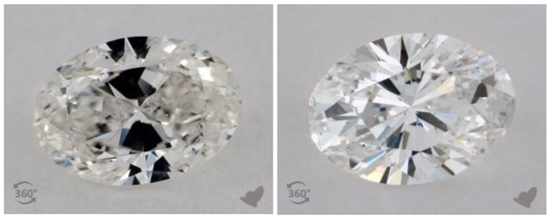 |
| Screenshot from James Allen Website |
A grading report can't tell you if the oval diamond has a large bowtie or not. To determine this, spin the diamond and examine it from all angles—the bowtie will be easy to spot. We suggest buying online from a store that has videos of the actual diamond, such as James Allen.
Estimate price:
For a 1 carat, H, VS2 oval diamond, price is $4,000 - $4,600
Best for:
The woman who appreciates tradition but still likes to express individuality.
Emerald Cut
 |
| Emerald Diamond Carat Size Chart © CreditDonkey |
The emerald is a step cut diamond. Unlike a brilliant cut, you're meant to enjoy it for depth and luster instead of brilliance. It has a large rectangular table that's like peering into a hall of mirrors. You can see all the way into an emerald diamond. The corners are faceted, so you will get some sparkliness at the edges.
This cut reached its heyday in the art-deco period of the 1920s and 30s but retains a sophisticated and timeless appeal. It looks gorgeous in vintage ring settings.
Advantages:
The emerald cut is one of the cheapest of all shapes, making it great for engagement rings on a budget. We recommend that you put any savings toward higher color and clarity grades.
Watch out:
Nothing can be hidden with this cut! Because of its depth and translucency, color or imperfections are easily spotted. We recommend a color of H and clarity of VS2 at the lowest. Go up to G and VS1 if the diamond is larger than 1 carat.
Furthermore, if the emerald diamond is poorly cut, a large area will appear black. Since fancy cut diamonds aren't given a cut grade, seeing photos of the diamond is the only way to know for sure.
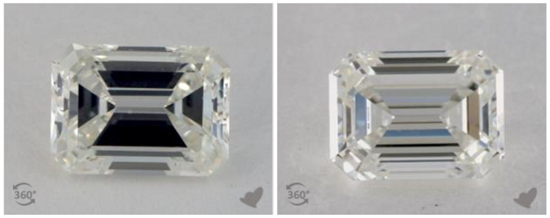 |
| Screenshot from James Allen Website |
The above shows an example of emerald cut diamonds with large blackout areas, and an ideal looking one.
Estimate price:
For a 1 carat, G, VS1 emerald diamond, price is $3,500 - $4,500
Best for:
The girl who loves all things art deco.
Asscher Cut
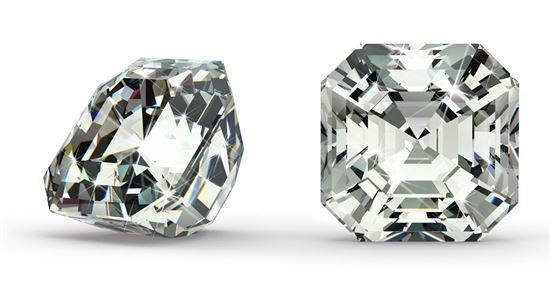 |
 |
| Asscher Diamond Carat Size Chart © CreditDonkey |
We think of this one as the modern vintage cut. The asscher diamond is another step cut from the art deco era, but with a modern update. Some refer to it as a square emerald though there are slight differences in style.
Advantages:
Compared to the emerald cut, the asscher has a higher crown, a smaller table, and larger step facets. This makes the cut more brilliant than its emerald cousin.
Watch out:
The asscher cut has 2 major drawbacks. First, it's among the priciest of the fancy-shaped diamonds. And with the deep square cut, it also has one of the smallest surface areas of any shape. But the trade-off is a unique look and shine that definitely stands out.
Just like with the emerald, you can easily spot yellow tints and flaws. The same tips for color and clarity apply when choosing this cut.
Estimate price:
For a 1 carat, G, VS2 asscher diamond, price is $4,000 - $5,000.
Best for:
The woman who enjoys a vintage look with a modern, sparkly twist.
View: Asscher Cut Diamonds on James Allen.
Radiant Cut
 |
| Radiant Diamond Carat Size Chart © CreditDonkey |
This cut is the hardest to classify. It's a hybrid of the round brilliant, princess, and asscher cuts. Because it takes the best of each, the radiant cut diamond displays incredible brilliance, fire, and scintillation.
Many people wonder about the difference between a radiant and princess cut. The radiant has cropped corners (like the asscher) and more of a chopped or "crushed ice" look . A princess cut has a symmetric X pattern when viewed face-up. These qualities depend on your personal preference!
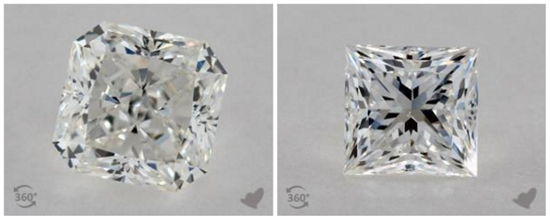 |
| Screenshot from James Allen Website |
Advantages:
As the name suggests, the radiant cut diamond is all sparkle. It can come in either rectangular or square shape. If you like the rectangular emerald shape but want something with more flash, the radiant is a great choice. Or if you prefer the square princess diamond minus the sharp corners, this cut can be a great compromise.
Watch out:
Radiant diamonds are often more expensive than princess cuts of the same carat weight because more rough material is lost during cutting. But it's a better choice for more active girls thanks to its cropped corners.
Estimate price:
For a 1 carat, H, VS2 radiant diamond, price is $3,500 - $4,500.
Best for:
The woman as unique as this cut.
View: Radiant Cut Diamonds on James Allen.
Pear Shaped Diamond
 |
| Pear Diamond Carat Size Chart © CreditDonkey |
The pear cut is the love child of the round brilliant cut and marquise. Elegant and with lots of character, it features a round edge that tapers to a point.
Advantages:
The pear shape is another cut that creates a slenderizing effect on the finger. Most women wear it with the end pointed towards the fingernail. It's also part of the brilliant cut family, so you can expect a lot of sparkle.
Watch out:
It's easy to chip the pointed, delicate tip of the teardrop. Protect it with a V-shaped prong.
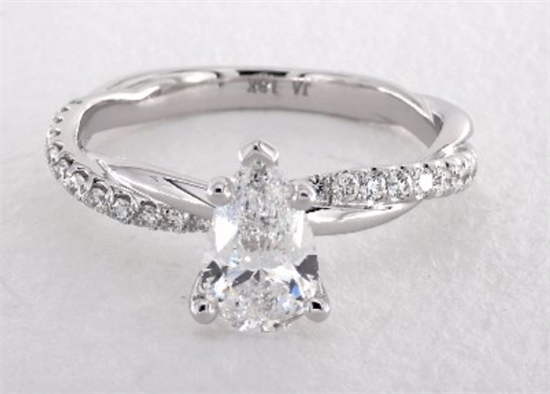 |
| Screenshot from James Allen Website |
Yellow tints may be visible, especially at the pointed tip where color tends to get trapped. If you want a white-looking diamond, we advise going 1 or 2 color grades up. Look for a color of H at the lowest and adjust up in grade as the diamond size increases.
Pear cut diamonds also exhibit the bow-tie effect (like an oval diamond). It's best if you're able to see it in person or at least a 360-degree video.
Estimate price:
For a 1 carat, G, VS2 pear diamond, price is $4,500 - $5,500.
Best for:
The elegant lady who likes to stand out.
Marquise Cut
 |
| Marquise Diamond Carat Size Chart © CreditDonkey |
A truly eye-catching shape, the marquise diamond is elongated with pointed ends. It's one of the rarest cuts—definitely the choice for the woman who's unafraid to stand out in a crowd! While certainly not for everyone, the marquise may grow on you with repeated viewings.
Advantages:
The elongated shape has a flattering effect on the finger. This diamond shape also looks HUGE compared to other shapes of the same carat weight. The marquise has the largest surface area of any shape.
Watch out:
Marquise diamonds share the same faults as ovals and pears. They also exhibit the bow-tie effect and the pointed tips trap more color. The same advice applies: look for a higher color grade, and never buy without being able to view the diamond at all angles.
Estimate price:
For a 1 carat, G, VS2 marquise diamond, price is $4,500 - $5,500.
Best for:
The woman who loves to be center of attention.
Heart Shaped Diamond
 |
| Heart Diamond Carat Size Chart © CreditDonkey |
A heart is the ultimate symbol of love. This is the shape for true romantics.
A stone over 0.5 carats is best--anything smaller and you won't be able to see the beautiful shape. A simple solitaire or bezel setting is the ideal showcase, though a thin pavé band or custom halo will work well, too. Other designs obscure the diamond's shape.
Advantages:
The heart shape is unique. It also looks adorable as a pink sapphire stone.
Watch out:
This is another challenging shape to buy! Pay attention to the shape of the heart. You want one with a clearly defined outline and symmetrical wings that are neither too rounded nor too flat, too fat nor too thin. A ratio of 0.9:1 or 1:1 (length to width) offers the best-looking heart shape.
 |
| Screenshot from James Allen Website |
Unfortunately, ugly heart-shaped diamonds are far too common. Most are cut to maximize size rather than for beauty. The first two pictures are examples of unattractive looking hearts (too thin and too fat), and the third is a beautiful, pleasing heart shape.
The grading report cannot tell you the final shape of the diamond. Once again, it's important to buy online ONLY from an retailer who provides actual images.
Estimate price:
For a 1 carat, H, VS2 heart shaped diamond, price is $4,000 - $5,000.
Best for:
The sentimental, hardcore romantic.
Rochelle Peachey, founder of transatlantic dating site I Love Your Accent
What You Need to Know about Diamond Shapes and Cuts
- What is the best cut of a diamond?
A round super-ideal cut is the best diamond and exhibits the most brilliance. Round is also the most popular cut for engagement rings, followed by the princess cut and the cushion cut.But "best cut" really depends on your personal preference. Some women love the timeless beauty of a round diamond. Others want something less mainstream for their engagement rings. Each diamond shape is unique.
Keep in mind, cut and shape are not the same. This terminology is easily mixed up. Diamond shape refers to the outline of the diamond, while diamond cut refers to the proportions.Cut affects how much light is reflected back, and therefore, how brilliant and beautiful the diamond appears. Because of this, you want the best cut possible. This would be GIA or AGS Excellent. However, fancy-shaped diamonds don't receive a cut grade. In this guide, we gave you some guidelines for optimal proportions for fancy diamonds.
- Which diamond shape looks biggest?
Elongated diamond shapes, such as marquise and pear cuts, look the biggest. The longer shape has a larger surface area compared to round or square diamonds (of the same carat weight). They look a lot bigger especially when worn on the finger.The diamond shapes that look the largest are:
- Marquise: has the largest surface area of all shapes
- Pear: has one pointy end that makes the diamond longer
- Oval: stretched out shape looks bigger than round
- Emerald: rectangular shape appears larger
On the other side of the spectrum, asscher and round diamonds look the smallest.
![1 Carat Diamond - Different Shapes Illustrated © CreditDonkey 1 Carat Diamond - Different Shapes Illustrated]()
1 Carat Diamond - Different Shapes Illustrated © CreditDonkey - Marquise: has the largest surface area of all shapes
- What is the best cut of diamond to sparkle?
Round brilliant cut diamonds exhibit the most sparkle. Because of their faceting pattern, they reflect the most light back to the viewer.The order of brilliance for the different cuts are:
- Round: has unmatched light performance
- Oval, marquise, pear, and heart: also in the brilliant cut family. They're cut in the same pattern as round, so they are very close in terms of brilliance.
- Princess: beloved for the intense sparkle it exhibits. Also close to round.
- Radiant: gets the best of a few cuts to create a beautiful brilliance
- Cushion: a popular shape, though unfortunately not as brilliant as others
- Asscher and emerald: these are in the step-cut family, which is not known for brilliance, but instead for shine and luster.
We cannot stress this enough: Though an Excellent cut is important to achieve the desired brilliance, a round diamond with poor proportions will appear dull, no matter how many facets it has. - Round: has unmatched light performance
- What diamond shapes are most expensive?
The most expensive diamond cut is the round brilliant - costing as much as 20% - 40% more than other shapes. This is because it takes more skill and precision to cut a round diamond. Also, more rough diamond is lost during cutting, which you also pay for.Here's an overall ranking of price:
- Round brilliant cut: most expensive
- Oval, marquise, and pear shape: these elongated stones take skill to cut
- Asscher cut: pricier because a lot more material is lost when making it
- Princess and radiant cut: these square/rectangular shapes don't waste a lot of material
- Cushion and heart shape: great brilliant stones for those on a budget
- Emerald shape: the least expensive diamond shape
In general, fancy-shaped diamonds cost 20%-40% less than a round diamond of the same carat weight.
- Round brilliant cut: most expensive
Bottom Line
Don't be overwhelmed by all the information. Here are the major points to remember:
- Round cuts give off the most brilliance. Their incredible sparkle can hide a multitude of flaws. This gives you more leeway when it comes to color and clarity.
- Round diamonds are also the most expensive, followed by oval, marquise, and asscher.
- Step cuts, like emerald and asscher, are not known for brilliance though they shine in a different way. These shapes easily reveal color and clarity flaws, so you'll need to choose higher grades in those areas.
- Fancy cuts, such as oval, marquise, and pear, exhibit a bow-tie effect. Look for a diamond whose bow-tie adds to its beauty.
- Only round and princess cut diamonds are given a cut grade by GIA.
- Seeing actual photos of fancy cut diamonds is ESSENTIAL since they are not given a cut grade. We recommend looking at James Allen which offers HD 360-degree videos for every diamond in their collection.
Every woman has unique interests and her own sense of style. The diamond shape will majorly impact the overall appearance of engagement rings. Take your time in finding the perfect diamond to match.
Write to Anna G at feedback@creditdonkey.com. Follow us on Twitter and Facebook for our latest posts.
Note: This website is made possible through financial relationships with some of the products and services mentioned on this site. We may receive compensation if you shop through links in our content. You do not have to use our links, but you help support CreditDonkey if you do.
|
|
|


